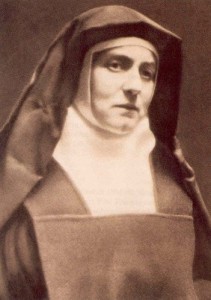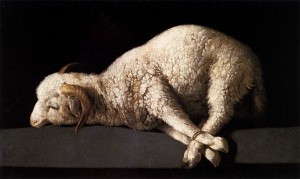The Science of the cross
On Good Friday, let us remember a Jewish woman, Edith Stein, who loved the cross and embraced its contradiction and mystery throughout her own life. There is a marvellous, life-size, bronze sculpture of Edith Stein in the centre of the German city of Cologne, close to the archdiocesan seminary. The sculpture depicts three Edith Steins at the three critical moments of her life. The first moment presents Edith as the young Jewish philosopher and professor, a student of Edmund Husserl. Edith is presented deep in meditation and a Star of David leans against her knee.
 The second depiction of the young woman shows Edith split in two. The artist shows her face and head almost divided. She moved from Judaism to agnosticism and even atheism. Hers was a painful search for the truth.
The second depiction of the young woman shows Edith split in two. The artist shows her face and head almost divided. She moved from Judaism to agnosticism and even atheism. Hers was a painful search for the truth.
The third representation is Edith as Sister Teresa Benedicta of the Cross, and she holds in her arms the crucified Christ: “Teresa blessed by the Cross” as her name indicates. She moved from Judaism, through atheism, to Christianity.
In her biography, we find a poignant moment from the critical period in her life, in Breslau, when she was moving beyond Judaism. Before her official entrance into the Carmel of Cologne, she had to face her Jewish mother. Her mother said to her daughter: “Edith, You can be religious also in the Jewish faith, don’t you think?”
Edith responded: “Sure, when you have never known anything else.”
Then her mother desperately replied: “And you, why did you know him? I don’t want to say anything against him; certainly he was a very good man; but why did he become God?”
The last weeks at home and the moment of separation were very painful. It was impossible to make her mother understand even a little. Edith wrote: “And yet I crossed the threshold of the Lord’s house in profound peace.”
Like Edith Stein, we encounter Jesus and his cross, and we have known something else. We have met Someone else: the Man of the cross. We have no alternative but to go to him.
After Edith had entered the Cologne Carmel, she continued to write her great work on the cross: Kreuzwissenschaft – the science of the cross. From Cologne she and her sister Rosa were deported to Echt in Holland and then rounded up with other Jews only to be sent to Auschwitz where she and her sister were burned to death by the evil Nazi regime on August 9, 1942.
On Good Friday we gather together as the Christian community to “behold the man” – Ecce Homo – and to gaze upon Jesus, who took upon himself all of our sins and failings so that we could experience peace and reconciliation with the One who sent him. If we have not truly encountered and embraced the Man of the cross our efforts are in vain. The validity of all of our efforts is determined by our embracing Jesus and his cross each day, by allowing the Paschal Mystery to transfigure our lives.
The cross of Jesus teaches us that what could have remained hideous and beyond remembrance is transformed into beauty, hope and new life. On Good Friday, may the cross be our true science, our comfort in time of trouble, our refuge in the face of danger, our safeguard on life’s journey, until the Lord welcomes us to our heavenly home. Let us continue to mark ourselves daily with the sign of the cross, and be ever mindful of what we are truly doing and professing with this sign:
“In the Name of the Father” We touch our minds because we know so little how to create a world of justice, peace and hope.
“In the Name of the Son” We touch the centre of our body to bring acceptance to the fears and pain Stemming from our own passage through death to life.
“In the Name of the Spirit” We embrace our heart to remember that from the centre of the Cross of Jesus, God’s vulnerable heart can bring healing and salvation to our own.
Fr. Thomas Rosica, CSB
CEO, Salt and Light Catholic Media Foundation


